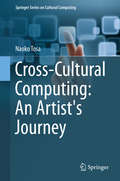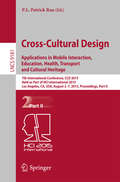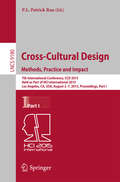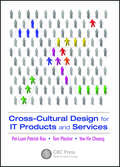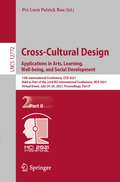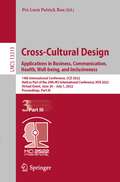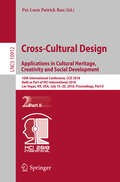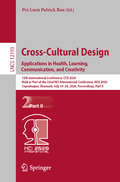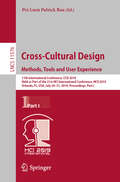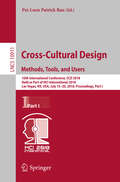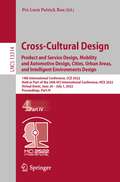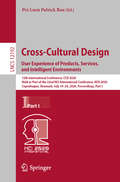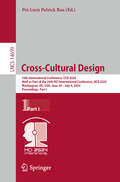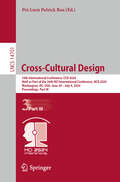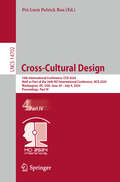- Table View
- List View
Cross-Border Life and Work: Social, Economic, Technological and Jurisdictional Issues (Contributions to Management Science)
by Stefan Seidel Peter Droege Stefan Güldenberg Marco J. MenichettiThis book discusses the risks, challenges, and opportunities of cross-border work and life from a multidisciplinary and multilevel perspective, including (a) the individual, (b) the social and organizational, and (c) the regional levels, taking into consideration the diverse and multilayered social, economic, technological, and jurisdictional issues involved.Emerging public policies and advanced information technologies (IT) have created new opportunities for work and life that thrive in global value chains and markets. Life, in general, and work, in particular, are increasingly organized across borders of various kinds and are subject to rapid change. At the same time, life and work have been determined by 19th and 20th century infrastructures and technologies. As a consequence, new strategies and measures are required for both physical and virtual work and life spaces.
Cross-Cultural Computing: An Artist's Journey (Springer Series on Cultural Computing)
by Naoko TosaThis exciting new book explores the relationship between cultural traditions and computers, looking at how people from very different cultures and backgrounds communicate and how the use of information technologies can support and enhance these dialogues. Historically we developed our understanding of other cultures through traditional means (museums, printed literature, etc. ) but the advent of information technologies has allowed us access to a plethora of material. Tosa asks the question "Can we understand other cultures using computers as media to supplement thinking and memorization?" Starting with a survey of art and technology, moving into the area of culture and technology, the book culminates with a vision of a new world based on an understanding of these relationships, allowing cultural creators and viewers the opportunity to reach a better and more profound understanding of the role information technology will play going forward.
Cross-Cultural Design Applications in Mobile Interaction, Education, Health, Transport and Cultural Heritage: 7th International Conference, CCD 2015, Held as Part of HCI International 2015, Los Angeles, CA, USA, August 2-7, 2015, Proceedings, Part II (Lecture Notes in Computer Science #9181)
by P.L. Patrick RauThe two LNCS volume set 9180-9181 constitutes the refereed proceedings of the 7th International Conference on Cross-Cultural Design, CCD 2015, held as part of the 17th International Conference on Human-Computer Interaction, HCII 2015, in Los Angeles, CA, USA in August 2015, jointly with 15 other thematically similar conferences. The total of 1462 papers and 246 posters presented at the HCII 2015 conferences were carefully reviewed and selected from 4843 submissions. These papers of the two volume set address as follows: LNCS 9180, Cross-Cultural Design: Methods, Practice and Impact (Part I), addressing the following major topics: cross-cultural product design, cross-cultural design methods and case studies, design, innovation, social development and sustainability and LNCS 9181, Cross-Cultural Design: Applications in Mobile Interaction, Education, Health, Transport and Cultural Heritage (Part II), addressing the following major topics: cultural aspects of social media and mobile services, culture for transport and travel, culture for design and design for culture and culture for health, learning and games.
Cross-Cultural Design Methods, Practice and Impact: 7th International Conference, CCD 2015, Held as Part of HCI International 2015, Los Angeles, CA, USA, August 2-7, 2015, Proceedings, Part I (Lecture Notes in Computer Science #9180)
by P.L.Patrick RauThe two LNCS volume set 9180-9181 constitutes the refereed proceedings of the 7th International Conference on Cross-Cultural Design, CCD 2015, held as part of the 17th International Conference on Human-Computer Interaction, HCII 2015, in Los Angeles, CA, USA in August 2015, jointly with 15 other thematically similar conferences. The total of 1462 papers and 246 posters presented at the HCII 2015 conferences were carefully reviewed and selected from 4843 submissions. These papers of the two volume set address as follows: LNCS 9180, Cross-Cultural Design: Methods, Practice and Impact (Part I), addressing the following major topics: cross-cultural product design, cross-cultural design methods and case studies, design, innovation, social development and sustainability and LNCS 9181, Cross-Cultural Design: Applications in Mobile Interaction, Education, Health, Transport and Cultural Heritage (Part II), addressing the following major topics: cultural aspects of social media and mobile services, culture for transport and travel, culture for design and design for culture and culture for health, learning and games.
Cross-Cultural Design for IT Products and Services
by Pei-Luen Rau Tom Plocher Yee-Yin ChoongWith the increase of globalization of business and industry, IT products and services are produced and marketed across geographical cultural boundaries without any consideration of culture. There is a high probability that IT products and services developed in one country may not be effectively used in another country, which may hinder market penetration and sales and use of IT products and services. This book provides comprehensive coverage of the psychological foundations of cross-cultural design. The text presents methodology for assessing similarities, differences, likes, dislikes and difficulties with different information appliance products and information services.
Cross-Cultural Design. Applications in Arts, Learning, Well-being, and Social Development: 13th International Conference, CCD 2021, Held as Part of the 23rd HCI International Conference, HCII 2021, Virtual Event, July 24–29, 2021, Proceedings, Part II (Lecture Notes in Computer Science #12772)
by Pei-Luen Patrick RauThe three-volume set LNCS 12771-12773 constitutes the refereed proceedings of the 13th International Conference on Cross-Cultural Design, CCD 2021, which was held as part of HCI International 2021 and took place virtually during July 24-29, 2021.The total of 1276 papers and 241 posters included in the 39 HCII 2021 proceedings volumes was carefully reviewed and selected from 5222 submissions. The papers included in the HCII-CCD volume set were organized in topical sections as follows: Part I: Cross-cultural experience design; cross-cultural product design; cultural differences and cross-cultural communication; Part II: Culture, arts and creativity; culture, learning and well-being; social change and social development; Part III: CCD in cultural heritage and tourism; CCD in autonomous vehicles and driving; CCD in virtual agents, robots and intelligent assistants.
Cross-Cultural Design. Applications in Business, Communication, Health, Well-being, and Inclusiveness: 14th International Conference, CCD 2022, Held as Part of the 24th HCI International Conference, HCII 2022, Virtual Event, June 26 – July 1, 2022, Proceedings, Part III (Lecture Notes in Computer Science #13313)
by Pei-Luen Patrick RauThe four-volume set LNCS 13311 - 13314 constitutes the refereed proceedings of the 14th International Conference on Cross-Cultural Design, CCD 2022, which was held as part of HCI International 2022 and took place virtually during June 26 - July 1, 2022. The papers included in the HCII-CCD volume set were organized in topical sections as follows: Part I: Cross-Cultural Interaction Design; Collaborative and Participatory Cross-Cultural Design; Cross-Cultural Differences and HCI; Aspects of Intercultural Design Part II: Cross-Cultural Learning, Training, and Education; Cross-Cultural Design in Arts and Music; Creative Industries and Cultural Heritage under a Cross-Cultural Perspective; Cross-Cultural Virtual Reality and Games Part III: Intercultural Business Communication; Intercultural Business Communication; HCI and the Global Social Change Imposed by COVID-19; Intercultural Design for Well-being and Inclusiveness Part IV: Cross-Cultural Product and Service Design; Cross-Cultural Mobility and Automotive UX Design; Design and Culture in Social Development and Digital Transformation of Cities and Urban Areas; Cross-Cultural Design in Intelligent Environments.
Cross-Cultural Design. Applications in Cultural Heritage, Creativity and Social Development: 10th International Conference, CCD 2018, Held as Part of HCI International 2018, Las Vegas, NV, USA, July 15-20, 2018, Proceedings, Part II (Lecture Notes in Computer Science #10912)
by Pei-Luen Patrick RauThis two-volume set LNCS 10911 and 10912 constitutes the refereed proceedings of the 10th International Conference on Cross-Cultural Design, CCD 2018, held as part of HCI International 2018 in Las Vegas, NV, USA, in July 2018.The total of 1170 papers and 195 posters included in the 30 HCII 2018 proceedings volumes was carefully reviewed and selected from 4373 submissions.The 37 regular papers presented in this volume were organized in topical sections named: culture, learning and games; culture and creativity; cross-cultural design for social change and development.
Cross-Cultural Design. Applications in Cultural Heritage, Tourism, Autonomous Vehicles, and Intelligent Agents: 13th International Conference, CCD 2021, Held as Part of the 23rd HCI International Conference, HCII 2021, Virtual Event, July 24–29, 2021, Proceedings, Part III (Lecture Notes in Computer Science #12773)
by Pei-Luen Patrick RauThe three-volume set LNCS 12771-12773 constitutes the refereed proceedings of the 13th International Conference on Cross-Cultural Design, CCD 2021, which was held as part of HCI International 2021 and took place virtually during July 24-29, 2021.The total of 1276 papers and 241 posters included in the 39 HCII 2021 proceedings volumes was carefully reviewed and selected from 5222 submissions.The papers included in the HCII-CCD volume set were organized in topical sections as follows:Part I: Cross-cultural experience design; cross-cultural product design; cultural differences and cross-cultural communication;Part II: Culture, arts and creativity; culture, learning and well-being; social change and social development;Part III: CCD in cultural heritage and tourism; CCD in autonomous vehicles and driving; CCD in virtual agents, robots and intelligent assistants.
Cross-Cultural Design. Applications in Health, Learning, Communication, and Creativity: 12th International Conference, CCD 2020, Held as Part of the 22nd HCI International Conference, HCII 2020, Copenhagen, Denmark, July 19–24, 2020, Proceedings, Part II (Lecture Notes in Computer Science #12193)
by Pei-Luen Patrick RauThis two-volume set LNCS 12192 and 12193 constitutes the refereed proceedings of the 12th International Conference on Cross-Cultural Design, CCD 2020, held as part of HCI International 2020 in Copenhagen, Denmark in July 2020.The conference was held virtually due to the corona pandemic. The total of 1439 papers and 238 posters included in the 40 HCII 2020 proceedings volumes was carefully reviewed and selected from 6326 submissions. The regular papers of Cross-Cultural Design CCD 2020 presented in this volume were organized in topical sections named: Health, Well-being and Social Design Across Cultures, Culture, Learning and Communication, and Culture and Creativity.
Cross-Cultural Design. Applications in Learning, Arts, Cultural Heritage, Creative Industries, and Virtual Reality: 14th International Conference, CCD 2022, Held as Part of the 24th HCI International Conference, HCII 2022, Virtual Event, June 26 – July 1, 2022, Proceedings, Part II (Lecture Notes in Computer Science #13312)
by Pei-Luen Patrick RauThe four-volume set LNCS 13311 - 13314 constitutes the refereed proceedings of the 14th International Conference on Cross-Cultural Design, CCD 2022, which was held as part of HCI International 2022 and took place virtually during June 26 - July 1, 2022. The papers included in the HCII-CCD volume set were organized in topical sections as follows: Part I: Cross-Cultural Interaction Design; Collaborative and Participatory Cross-Cultural Design; Cross-Cultural Differences and HCI; Aspects of Intercultural Design Part II: Cross-Cultural Learning, Training, and Education; Cross-Cultural Design in Arts and Music; Creative Industries and Cultural Heritage under a Cross-Cultural Perspective; Cross-Cultural Virtual Reality and Games Part III: Intercultural Business Communication; Intercultural Business Communication; HCI and the Global Social Change Imposed by COVID-19; Intercultural Design for Well-being and Inclusiveness Part IV: Cross-Cultural Product and Service Design; Cross-Cultural Mobility and Automotive UX Design; Design and Culture in Social Development and Digital Transformation of Cities and Urban Areas; Cross-Cultural Design in Intelligent Environments.
Cross-Cultural Design. Culture and Society: 11th International Conference, CCD 2019, Held as Part of the 21st HCI International Conference, HCII 2019, Orlando, FL, USA, July 26–31, 2019, Proceedings, Part II (Lecture Notes in Computer Science #11577)
by Pei-Luen Patrick RauThis two-volume set LNCS 11576 and 11577 constitutes the thoroughly refereed proceedings of the 11th International Conference on Cross-Cultural Design, CCD 2019, which was held as part of the 21st HCI International Conference, HCII 2019, in Orlando, FL, USA, in July 2019. The total of 1275 papers and 209 posters included in the 35 HCII 2019 proceedings volumes were carefully reviewed and selected from 5029 submissions. CCD 2019 includes a total of 80 papers; they were organized in topical sections named: Part I, Methods, Tools and User Experience: Cross-cultural design methods and tools; culture-based design; cross-cultural user experience; cultural differences, usability and design; aesthetics and mindfulness.Part II, Culture and Society: Cultural products; experiences and creativity; design for social change and development; cross-cultural product and service design; intercultural learning.
Cross-Cultural Design. Experience and Product Design Across Cultures: 13th International Conference, CCD 2021, Held as Part of the 23rd HCI International Conference, HCII 2021, Virtual Event, July 24–29, 2021, Proceedings, Part I (Lecture Notes in Computer Science #12771)
by Pei-Luen Patrick RauThe three-volume set LNCS 12771-12773 constitutes the refereed proceedings of the 13th International Conference on Cross-Cultural Design, CCD 2021, which was held as part of HCI International 2021 and took place virtually during July 24-29, 2021.The total of 1276 papers and 241 posters included in the 39 HCII 2021 proceedings volumes was carefully reviewed and selected from 5222 submissions.The papers included in the HCII-CCD volume set were organized in topical sections as follows:Part I: Cross-cultural experience design; cross-cultural product design; cultural differences and cross-cultural communication;Part II: Culture, arts and creativity; culture, learning and well-being; social change and social development;Part III: CCD in cultural heritage and tourism; CCD in autonomous vehicles and driving; CCD in virtual agents, robots and intelligent assistants.
Cross-Cultural Design. Interaction Design Across Cultures: 14th International Conference, CCD 2022, Held as Part of the 24th HCI International Conference, HCII 2022, Virtual Event, June 26 – July 1, 2022, Proceedings, Part I (Lecture Notes in Computer Science #13311)
by Pei-Luen Patrick RauThe four-volume set LNCS 13311 - 13314 constitutes the refereed proceedings of the 14th International Conference on Cross-Cultural Design, CCD 2022, which was held as part of HCI International 2022 and took place virtually during June 26 - July 1, 2022. The papers included in the HCII-CCD volume set were organized in topical sections as follows: Part I: Cross-Cultural Interaction Design; Collaborative and Participatory Cross-Cultural Design; Cross-Cultural Differences and HCI; Aspects of Intercultural Design Part II: Cross-Cultural Learning, Training, and Education; Cross-Cultural Design in Arts and Music; Creative Industries and Cultural Heritage under a Cross-Cultural Perspective; Cross-Cultural Virtual Reality and Games Part III: Intercultural Business Communication; Intercultural Business Communication; HCI and the Global Social Change Imposed by COVID-19; Intercultural Design for Well-being and Inclusiveness Part IV: Cross-Cultural Product and Service Design; Cross-Cultural Mobility and Automotive UX Design; Design and Culture in Social Development and Digital Transformation of Cities and Urban Areas; Cross-Cultural Design in Intelligent Environments.
Cross-Cultural Design. Methods, Tools and User Experience: 11th International Conference, CCD 2019, Held as Part of the 21st HCI International Conference, HCII 2019, Orlando, FL, USA, July 26–31, 2019, Proceedings, Part I (Lecture Notes in Computer Science #11576)
by Pei-Luen Patrick RauThis two-volume set LNCS 11576 and 11577 constitutes the thoroughly refereed proceedings of the 11th International Conference on Cross-Cultural Design, CCD 2019, which was held as part of the 21st HCI International Conference, HCII 2019, in Orlando, FL, USA, in July 2019. The total of 1275 papers and 209 posters included in the 35 HCII 2019 proceedings volumes were carefully reviewed and selected from 5029 submissions. CCD 2019 includes a total of 80 papers; they were organized in topical sections named: Part I, Methods, Tools and User Experience: Cross-cultural design methods and tools; culture-based design; cross-cultural user experience; cultural differences, usability and design; aesthetics and mindfulness. Part II, Culture and Society: Cultural products; experiences and creativity; design for social change and development; cross-cultural product and service design; intercultural learning.
Cross-Cultural Design. Methods, Tools, and Users: 10th International Conference, CCD 2018, Held as Part of HCI International 2018, Las Vegas, NV, USA, July 15-20, 2018, Proceedings, Part I (Lecture Notes in Computer Science #10911)
by Pei-Luen Patrick RauThis two-volume set LNCS 10911 and 10912 constitutes the refereed proceedings of the 10th International Conference on Cross-Cultural Design, CCD 2018, held as part of HCI International 2018 in Las Vegas, NV, USA, in July 2018.The total of 1170 papers and 195 posters included in the 30 HCII 2018 proceedings volumes was carefully reviewed and selected from 4373 submissions.The 36 regular papers presented in this volume were organized in topical sections named: cross-cultural design methods and tools; cross-cultural product design; cultural Differences; and culture, emotions and design.
Cross-Cultural Design. Product and Service Design, Mobility and Automotive Design, Cities, Urban Areas, and Intelligent Environments Design: 14th International Conference, CCD 2022, Held as Part of the 24th HCI International Conference, HCII 2022, Virtual Event, June 26 – July 1, 2022, Proceedings, Part IV (Lecture Notes in Computer Science #13314)
by Pei-Luen Patrick RauThe four-volume set LNCS 13311 - 13314 constitutes the refereed proceedings of the 14th International Conference on Cross-Cultural Design, CCD 2022, which was held as part of HCI International 2022 and took place virtually during June 26 - July 1, 2022. The papers included in the HCII-CCD volume set were organized in topical sections as follows: Part I: Cross-Cultural Interaction Design; Collaborative and Participatory Cross-Cultural Design; Cross-Cultural Differences and HCI; Aspects of Intercultural Design Part II: Cross-Cultural Learning, Training, and Education; Cross-Cultural Design in Arts and Music; Creative Industries and Cultural Heritage under a Cross-Cultural Perspective; Cross-Cultural Virtual Reality and Games Part III: Intercultural Business Communication; Intercultural Business Communication; HCI and the Global Social Change Imposed by COVID-19; Intercultural Design for Well-being and Inclusiveness Part IV: Cross-Cultural Product and Service Design; Cross-Cultural Mobility and Automotive UX Design; Design and Culture in Social Development and Digital Transformation of Cities and Urban Areas; Cross-Cultural Design in Intelligent Environments.
Cross-Cultural Design. User Experience of Products, Services, and Intelligent Environments: 12th International Conference, CCD 2020, Held as Part of the 22nd HCI International Conference, HCII 2020, Copenhagen, Denmark, July 19–24, 2020, Proceedings, Part I (Lecture Notes in Computer Science #12192)
by Pei-Luen Patrick RauThis two-volume set LNCS 12192 and 12193 constitutes the refereed proceedings of the 12th International Conference on Cross-Cultural Design, CCD 2020, held as part of HCI International 2020 in Copenhagen, Denmark in July 2020.The conference was held virtually due to the corona pandemic. The total of 1439 papers and 238 posters included in the 40 HCII 2020 proceedings volumes was carefully reviewed and selected from 6326 submissions. The regular papers of Cross-Cultural Design CCD 2020 presented in this volume were organized in topical sections named: Cross-Cultural User Experience Design; Culture-Based Design, Cross-Cultural Behaviour and Attitude, and Cultural Facets of Interactions with Autonomous Agents and Intelligent Environments.
Cross-Cultural Design: 15th International Conference, CCD 2023, Held as Part of the 25th International Conference, HCII 2023, Copenhagen, Denmark, July 23–28, 2023, Proceedings, Part I (Lecture Notes in Computer Science #14022)
by Pei-Luen Patrick RauThis three-volume set of CCD 2023, constitutes the refereed proceedings of the 25th International Conference on Cross-Cultural Design, CCD 2023, held as Part of the 24th International Conference, HCI International 2023, which took place in July 2023 in Copenhagen, Denmark. The total of 1578 papers and 396 posters included in the HCII 2023 proceedings volumes was carefully reviewed and selected from 7472 submissions. The papers of CCD 2023, Part I address topics related to service and product design for cultural innovation, design for social change and development, sustainable design methods and practices, and cross-cultural perspectives on design and consumer behavior.
Cross-Cultural Design: 15th International Conference, CCD 2023, Held as Part of the 25th International Conference, HCII 2023, Copenhagen, Denmark, July 23–28, 2023, Proceedings, Part II (Lecture Notes in Computer Science #14023)
by Pei-Luen Patrick RauThis three-volume set of CCD 2023, constitutes the refereed proceedings of the 25th International Conference on Cross-Cultural Design, CCD 2023, held as Part of the 24th International Conference, HCI International 2023, which took place in July 2023 in Copenhagen, Denmark. The total of 1578 papers and 396 posters included in the HCII 2023 proceedings volumes was carefully reviewed and selected from 7472 submissions. The papers of CCD 2023, Part II address topics related to user experience design in emerging technologies, future-focused design, as well as culturally-informed design of automated and intelligent systems.
Cross-Cultural Design: 15th International Conference, CCD 2023, Held as Part of the 25th International Conference, HCII 2023, Copenhagen, Denmark, July 23–28, 2023, Proceedings, Part III (Lecture Notes in Computer Science #14024)
by Pei-Luen Patrick RauThis three-volume set of CCD 2023, constitutes the refereed proceedings of the 25th International Conference on Cross-Cultural Design, CCD 2023, held as Part of the 24th International Conference, HCI International 2023, which took place in July 2023 in Copenhagen, Denmark. The total of 1578 papers and 396 posters included in the HCII 2023 proceedings volumes was carefully reviewed and selected from 7472 submissions. The papers of CCD 2023, Part III address topics related to cross-cultural design in arts and creative industries, in cultural heritage, in immersive and inclusive learning environments, as well as cross-cultural health and wellness design.
Cross-Cultural Design: 16th International Conference, CCD 2024, Held as Part of the 26th HCI International Conference, HCII 2024, Washington, DC, USA, June 29 – July 4, 2024, Proceedings, Part I (Lecture Notes in Computer Science #14699)
by Pei-Luen Patrick RauThis four-volume set LNCS 14699-14702 constitutes the thoroughly refereed proceedings of the 16th International Conference on Cross-Cultural Design 2024 (CCD 2024), held as part of the 26th International Conference on Human-Computer Interaction, HCI International 2024 (HCII 2024), was held as a hybrid event in Washington DC, USA, during June/July 2024. The total of 1271 papers and 309 posters included in the HCII 2023 proceedings was carefully reviewed and selected from 5108 submissions. The CCD 2024 conference focuses a broad range of theoretical and applied issues related to Cross-Cultural Design and its applications, and much more.
Cross-Cultural Design: 16th International Conference, CCD 2024, Held as Part of the 26th HCI International Conference, HCII 2024, Washington, DC, USA, June 29 – July 4, 2024, Proceedings, Part II (Lecture Notes in Computer Science #14700)
by Pei-Luen Patrick RauThis four-volume set LNCS 14699-14702 constitutes the thoroughly refereed proceedings of the 16th International Conference on Cross-Cultural Design 2024 (CCD 2024), held as part of the 26th International Conference on Human-Computer Interaction, HCI International 2024 (HCII 2024), was held as a hybrid event in Washington DC, USA, during June/July 2024. The total of 1271 papers and 309 posters included in the HCII 2023 proceedings was carefully reviewed and selected from 5108 submissions. The CCD 2024 conference focuses a broad range of theoretical and applied issues related to Cross-Cultural Design and its applications, and much more.
Cross-Cultural Design: 16th International Conference, CCD 2024, Held as Part of the 26th HCI International Conference, HCII 2024, Washington, DC, USA, June 29 – July 4, 2024, Proceedings, Part III (Lecture Notes in Computer Science #14701)
by Pei-Luen Patrick RauThis four-volume set LNCS 14699-14702 constitutes the thoroughly refereed proceedings of the 16th International Conference on Cross-Cultural Design 2024 (CCD 2024), held as part of the 26th International Conference on Human-Computer Interaction, HCI International 2024 (HCII 2024), was held as a hybrid event in Washington DC, USA, during June/July 2024. The total of 1271 papers and 309 posters included in the HCII 2023 proceedings was carefully reviewed and selected from 5108 submissions. The CCD 2024 conference focuses a broad range of theoretical and applied issues related to Cross-Cultural Design and its applications, and much more.
Cross-Cultural Design: 16th International Conference, CCD 2024, Held as Part of the 26th HCI International Conference, HCII 2024, Washington, DC, USA, June 29 – July 4, 2024, Proceedings, Part IV (Lecture Notes in Computer Science #14702)
by Pei-Luen Patrick RauThis four-volume set LNCS 14699-14702 constitutes the thoroughly refereed proceedings of the 16th International Conference on Cross-Cultural Design 2024 (CCD 2024), held as part of the 26th International Conference on Human-Computer Interaction, HCI International 2024 (HCII 2024), was held as a hybrid event in Washington DC, USA, during June/July 2024. The total of 1271 papers and 309 posters included in the HCII 2023 proceedings was carefully reviewed and selected from 5108 submissions. The CCD 2024 conference focuses a broad range of theoretical and applied issues related to Cross-Cultural Design and its applications, and much more.

